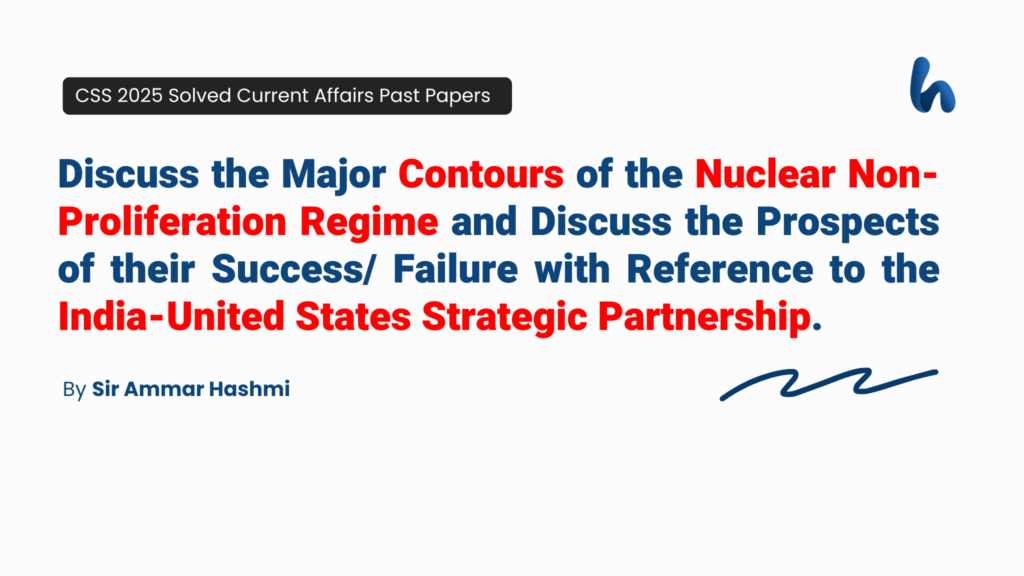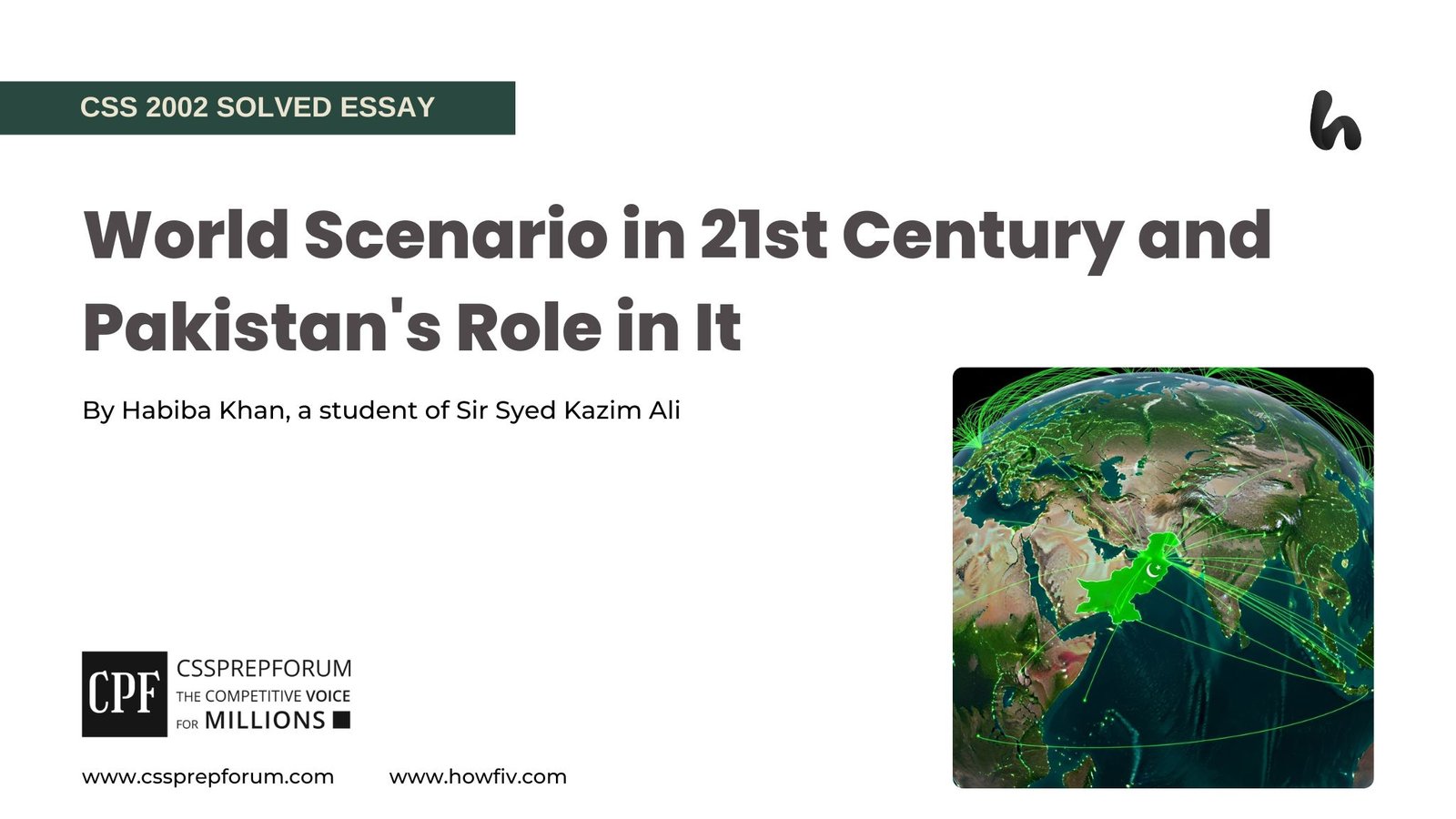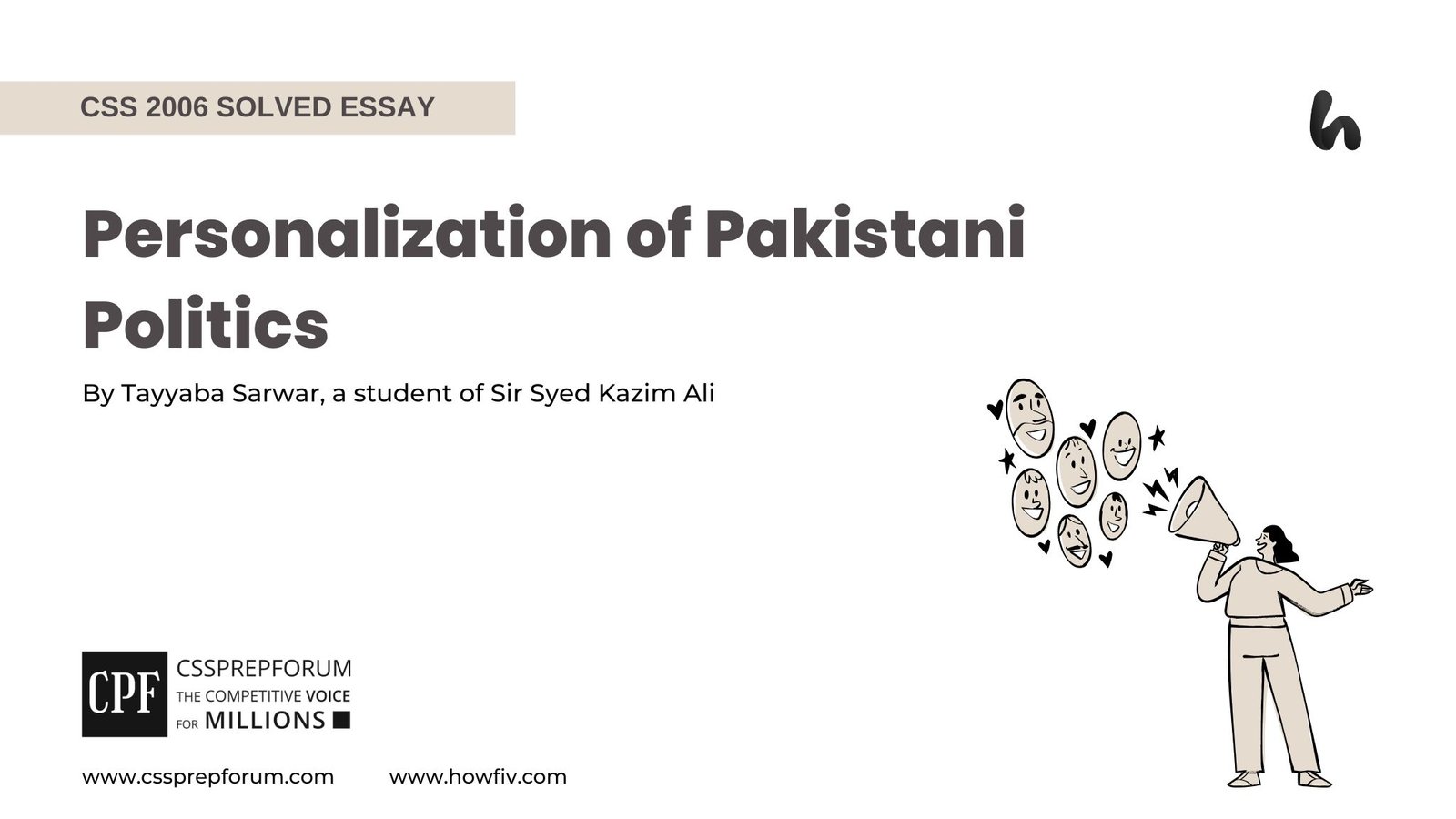CSS 2025 Solved Current Affairs Past Papers | Nuclear Non-Proliferation Regimes and India-US Partnership
The following question of CSS Current Affairs 2025 is solved by Sir Ammar Hashmi, the best Current Affairs Coach, on the guided pattern of Sir Syed Kazim Ali, which he taught to his students, scoring the highest marks in compulsory subjects for years. This solved past paper question is uploaded to help aspirants understand how to crack a topic or question, how to write relevantly, what coherence is, and how to include and connect ideas, opinions, and suggestions to score the maximum.

Question Breakdown
This question addresses the major contours of the Nuclear Proliferation Regime and the prospects of their failures due to the India-United States Strategic Partnership
Outline
1-Introduction
2-Understanding the Major Contours of Nuclear Non-Proliferation
- International Atomic Energy Agency (IAEA) 1957
- Non-Proliferation Treaty (NPT) 1968
- Nuclear Supplier Group (NSG) 1974
- Comprehensive Test Ban Treaty (CTBT) 1996
3-Unwinding India-United States Strategic Relations
4-prospects of failure of Nuclear Non-Proliferation Regime due to India-United States Strategic Relation
- ✓ Diminishing global consensus against Non-Proliferation Regime
- ✓ Destabilizing strategic stability of South Asia
- ✓ Provoking other nations to violate Non-Proliferation Regime
- ✓ Impetus for non-nuclear states to pursue nuclearization
5-Critical Analysis
6-Conclusion

Answer to the question
Introduction
Nuclear Non-Proliferation Regime based on the notion of human security advocates for abandoning nuclear weapons for a peaceful world. The regime’s organizational body, the International Atomic Energy Agency (IAEA), and treaties like the Non-Proliferation Treaty and the Comprehensive Test Ban Treaty (CTBT) have substantially hindered nuclear proliferation. For instance, thwarting nuclear ambitions by states like Germany, Brazil, and Japan showcases the importance and influence of the Non-Proliferation Regime. However, certain challenges hinder the prospects of a nuclear-free world. For example, the growing United States (US)-India bilateral strategic relations to curtail China’s influence in the Indo-Pacific have significant implications for the Nuclear Non-Proliferation Regime. The two strategic partners signed the nuclear deal, also known as the 123 Agreement 2008, breaching the Nuclear Supplier Group’s (NSG) principles. Besides technology transfer to build Nuclear Reactors in India, the US acknowledges the commissioning of Indian Nuclear Submarines Arihant and Arighaat in the Indian Ocean as a strategic gain. The disproportionate application of the Nuclear Non-Proliferation Regime by the global hegemon to other countries like Pakistan, Iran, and North Korea provokes security dilemmas, gives impetus to nuclearization, and undermines the effectiveness of international consensus on non-proliferation.

Understanding the Major Contours of the Nuclear Non-Proliferation Regime
The Nuclear Non-Proliferation Regime configures organizations like the International Atomic Energy Agency (IAEA), associations like the Nuclear Supplier Group (NSG), and treaties like the Non-Proliferation Treaty (NPT) and the Comprehensive Test Ban Treaty (CTBT) to curb nuclear proliferation. It scrutinizes nuclear developments by inspecting stockpiles, documenting enrichments, and profiling violators and abiders.
- ✓ International Atomic Energy Agency (IAEA) 1957
The International Atomic Energy Agency (IAEA) was established in 1957 by the United Nations. The agency was set up to deter any deviation from civilian nuclear facilities to military purposes. The agency’s specialized teams regularly visit civilian nuclear facilities, check inventories, and ensure the peaceful use of nuclear energy. Importantly, the agency played an essential role in materializing the Iran Nuclear Deal in 2015, hindering the nuclearization of the country through regular inspections and showing compliance with international protocols.
- ✓ Non-Proliferation Treaty (NPT) 1968
The Non-Proliferation Treaty (NPT), which was adopted in 1968, is a significant milestone in the struggle against Nuclear Proliferation. The treaty has universal extension and is of considerable importance, having been signed by five major nuclear powers: China, France, the United States (US), the United Kingdom (UK), and Russia. The treaty promotes non-proliferation, security of non-nuclear states, and cooperation for the safe utilization of nuclear energy. The treaty had achieved the significant milestone of slowing the pace of nuclearization during the Cold War era. Countries like Japan, Brazil, and Germany threw away their ambitions of producing nuclear weapons, a massive success of the Non-Proliferation Treaty.
- ✓ Nuclear Supplier Group (NSG) 1975
The Nuclear Supplier Group (NSG) is a voluntary multilateral association of forty-eight countries. The group was formed after nuclear tests conducted by India in 1975. The group regulates nuclear exports between member states to ensure the peaceful use of nuclear facilities. Similarly, the group hinders nuclear exports to non-member states. Unfortunately, the group guidelines lack legal binding, which makes them vulnerable to being breached in the case of national interests. The exemption provided by the United States (US) to India is a historical example of the violation of group principles.
- ✓ Comprehensive Test Ban Treaty (CTBT) 1996
The Comprehensive Test Ban Treaty (CTBT) was adopted in 1996 to tackle nuclear proliferation by limiting fissile material production. The treaty banned nuclear test explosions and limited fissile material production only for civilian purposes. Unfortunately, the treaty failed to manoeuvre its objectives as any nuclear state did not sign it.
Unwinding India-United States Strategic Relations
The India-United States (US) strategic relations have experienced a substantial boost in the last decade. The US announced India as a strategic partner in its 2017 Indo-Pacific Policy. Having a common goal to tackle the influence of China in the Indo-Pacific region, the two countries have signed numerous strategic agreements like the Logistics Exchange Memorandum of Agreement (LEMA ), the Communications Compatibility and Security Agreement (COMSCA), and the U.S.-India initiative on Critical and Emerging Technology (ICET). These agreements cover logistical support, intelligence, technology share, and defence sectors to achieve a common objective. However, in the nuclear context, the US-India Nuclear Deal signed in 2008 is of remarkable considerance. Also known as the 123 Agreement, the deal gave India a waiver from the Nuclear Support Group’s guidelines. Furthermore, the US acknowledges the recent commissioning of the Indian Nuclear Submarines Arihant and Arighaat in the Indian Ocean as a strategic push to counter China’s regional hegemony.
Prospects of failure of Nuclear Non-Proliferation Regime due to India-United States Strategic Relation
There are multiple prospects of the failure of the Nuclear Non-Proliferation Regime due to the United States-India Strategic relations. The transfer of technology, under the 123 Agreement, by the US to build six Nuclear Reactors inside India violates the principles of the Nuclear Supplier Group (NSG) and the Non-Proliferation Treaty (NPT). This unequal treatment of countries like Pakistan, Iran, and India obscures the fate of non-proliferation.
- ✓ Diminishing global consensus against Non-Proliferation Regime
The unabated support of the United States (US) to India has greatly damaged the global consensus against nuclear non-proliferation. The waiver provided to India has paved the way for other influential states to undermine the norms of the Nuclear- Non-Proliferation Regime. Similarly, it reflects the rule of power politics despite rule-based order, making nuclear proliferation a significant component of great power rivalry.
- ✓ Destabilizing strategic stability of South Asia
The extended support of the United States (US) to India destabilizes the strategic stability of South Asia. To illustrate, India’s increasing nuclearization of the Indian Ocean and stockpiling of warheads backed by the US shifted the balance of strategic stability towards India. According to the Stockholm International Peace Research Institute’s (SIPRI) annual review 2024, India’s increasing number of warheads has crossed Pakistan and is now focusing on competing with China. In the modern era, such a fast pace of nuclearization has significantly blurred the principles of non-proliferation.
- ✓ Provoking other nations to violate Non-Proliferation Regime
India’s ambitions of nuclearization backed by its strategic partner, the United States (US), aggravates the disparity of its neighbouring states like Pakistan and China. Consequently, to equalize regional nuclear deterrence, Pakistan and China continuously strive to upgrade their nuclear assets. For example, according to the Stockholm International Peace Research Institute’s (SIPRI) annual review 2024, China is expanding its nuclear arsenal faster than any other country, which reflects the arms race perpetuated by India-US strategic relations
- ✓ Impetus for non-nuclear states to pursue nuclearization
The strategic relations between India and the United States and violation of international non-proliferation protocols give an impetus to non-nuclear states to achieve nuclear status. Given the security dilemma produced as a result of India’s strategic leverage, the neighbouring states aim to secure national security through nuclear weapons acquisition. Iran’s growing enrichment of Uranium to achieve nuclear status is a glaring example of non-nuclear states’ ambition of nuclear weapons to guarantee national security.
Critical Analysis
The Nuclear Non-Proliferation Regime has taken significant steps to hinder nuclear proliferation and disarm nuclear weapons. However, nuclear states have not shown any compliance effectively, citing that nuclear weapons are inevitable for national security. On the other hand, strategic relations between India-United States (US) undermine Nuclear Non-Proliferation guidelines by transferring nuclear technology to India, a non-NPT state. Such strategic relations could provoke regional security dilemmas and nuclearization. According to Researcher Oliver Meier, “the acceptance of India into the circle of recognized Nuclear weapon states proved that universally and generally binding principles are no longer formed on the basis of global non-proliferation efforts, but rather western countries were increasingly deciding good and bad proliferation”.
Conclusion
In a nutshell, the Nuclear Non-Proliferation Regime’s fate rests on the will of great powers politics. The United States (US)backing of India’s exemption from the Nuclear Supplier Group (NSG) manifests the possibility of breaching non-proliferation principles by any other major power. Thus, a uniform charter of non-proliferation should be adopted by all states to curb the menace of nuclear proliferation.

CSS Solved Past Papers’ Essays
Looking for the last ten years of CSS and PMS Solved Essays and want to know how Sir Kazim’s students write and score the highest marks in the essays’ papers? Then, click on the CSS Solved Essays to start reading them.
CSS Solved Essays
CSS Solved General Science & Ability Past Papers
Want to read the last ten years’ General Science & Ability Solved Past Papers to learn how to attempt them and to score high? Let’s click on the link below to read them all freely. All past papers have been solved by Pakistan’s top CSS GSA coach having the highest score of their students.
General Science & Ability Solved Past Papers












